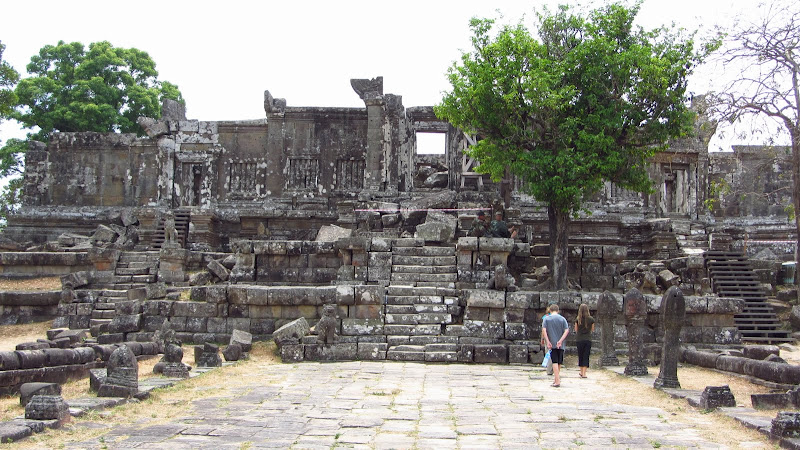 Preah Vihear is an ancient Khmer temple on the border with Thailand. It was built high on a hilltop in the ninth century near the beginning of the Khmer empire. It took us about five hours of travel to get from Siem Reap to the start of the trail up to the temple.
Preah Vihear is an ancient Khmer temple on the border with Thailand. It was built high on a hilltop in the ninth century near the beginning of the Khmer empire. It took us about five hours of travel to get from Siem Reap to the start of the trail up to the temple.  We drove several hours through the Cambodian countryside, stopping for breakfast in a small roadside cafe. At the bottom of the hill, we handed our passports to the tourist police and paid five dollars for a motocycle ride up a very steep road to the trailhead. Why, you may ask, would one need a passport to visit a temple? You see, there is a struggle between Cambodia and Thailand over who owns the temple. In fact, there are full-on military skirmishes with missiles flying and soldiers dying.
We drove several hours through the Cambodian countryside, stopping for breakfast in a small roadside cafe. At the bottom of the hill, we handed our passports to the tourist police and paid five dollars for a motocycle ride up a very steep road to the trailhead. Why, you may ask, would one need a passport to visit a temple? You see, there is a struggle between Cambodia and Thailand over who owns the temple. In fact, there are full-on military skirmishes with missiles flying and soldiers dying.
The temple is on the Cambodian side of the border with Thailand, but the Thai believe it belongs in Thailand.  Apparently, a bit over 100 years ago, a map was drawn delineating the border.
Apparently, a bit over 100 years ago, a map was drawn delineating the border.  The border was to follow the watershed, along the ridge of a mountain. If the ridge was followed, Preah Vihear would have ended up in Thailand. Yet when Siam and the French colonists of Cambodia drew the map, the border made a marked deviation around the temple placing it in Cambodia. The Siamese at the time did not object. Of course, the Cambodians believe the temple is part of their cultural heritage. It was built by the Khmer Empire which was defeated by the Siamese only long after all the temples were built. The Cambodian 2000 riel bill even bears a picture of the temple.
The border was to follow the watershed, along the ridge of a mountain. If the ridge was followed, Preah Vihear would have ended up in Thailand. Yet when Siam and the French colonists of Cambodia drew the map, the border made a marked deviation around the temple placing it in Cambodia. The Siamese at the time did not object. Of course, the Cambodians believe the temple is part of their cultural heritage. It was built by the Khmer Empire which was defeated by the Siamese only long after all the temples were built. The Cambodian 2000 riel bill even bears a picture of the temple.
 In July, 2008, the temple became a UNESCO World Heritage Site, a designation designed to help preserve cultural sites around the world. The flags of UNESCO fly over the temple implying harmony between nations. But in October, 2008, the military clashes began. Multiple soldiers have died on both sides. A village at the base of the temple burned during one of the battles displacing 300 people.
In July, 2008, the temple became a UNESCO World Heritage Site, a designation designed to help preserve cultural sites around the world. The flags of UNESCO fly over the temple implying harmony between nations. But in October, 2008, the military clashes began. Multiple soldiers have died on both sides. A village at the base of the temple burned during one of the battles displacing 300 people.  Land mines are scattered under the ground surrounding the temple. People still find them accidentally with traumatic results. Cambodia swears it is no longer placing land mines. Who knows? There is certainly animosity from the Cambodian soldiers toward the Thai soldiers. Bill asked the soldiers if they ever had a beer with the Thai. They couldn’t even conceive of the idea. No, they will shoot us, they said, we shoot the Thai soldiers if we see them. They then asked if America could send them some missiles.
Land mines are scattered under the ground surrounding the temple. People still find them accidentally with traumatic results. Cambodia swears it is no longer placing land mines. Who knows? There is certainly animosity from the Cambodian soldiers toward the Thai soldiers. Bill asked the soldiers if they ever had a beer with the Thai. They couldn’t even conceive of the idea. No, they will shoot us, they said, we shoot the Thai soldiers if we see them. They then asked if America could send them some missiles.
 As we walked the trail, soldiers followed us.
As we walked the trail, soldiers followed us.  Their presence implied we were protected. Really it was just to get a dollar or a pack of cigarettes as a tip. The main temple is on the top of a hill involving a lot of climbing. After only a short climb, our driver told us the soldiers were done and needed a dollar. Easy enough. Glad to be rid of them. We also had a “guide” in the form a member of the tourist police, but he spoke little to no English and knew no history of the temple. A little later, he got a dollar. On our own we found the carving of the Churning of the Sea of Milk. It was rudimentary compared with the famous one at Angkor Wat, but it seems to be a theme among the temples. We felt we had met our goal when we found it.
Their presence implied we were protected. Really it was just to get a dollar or a pack of cigarettes as a tip. The main temple is on the top of a hill involving a lot of climbing. After only a short climb, our driver told us the soldiers were done and needed a dollar. Easy enough. Glad to be rid of them. We also had a “guide” in the form a member of the tourist police, but he spoke little to no English and knew no history of the temple. A little later, he got a dollar. On our own we found the carving of the Churning of the Sea of Milk. It was rudimentary compared with the famous one at Angkor Wat, but it seems to be a theme among the temples. We felt we had met our goal when we found it.
It was then time for lunch. We chose a spot overlooking the Cambodian broad, flat countryside and over the border to Thailand. It was beautiful. 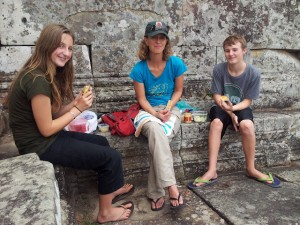 I laid out the picnic on the sandstone blocks of the temple. We enjoyed crackers and cheese, sandwiches and watermelon. After we ate, we watched as tiny ants struggled to move crumbs of crackers toward their home in the cracks between the blocks. Crumbs easily ten times the size of each ant were hurried along, often by two or three ants at a time. They moved together so quickly for such a big job. They didn’t approach the crumb from one side, but surrounded it on all sides. One pushed forward, one pushed sideways, and one pulled backwards. They’d constantly spin around holding onto their crumb, but they always moved forward. Somehow they worked in unison toward their goal. The ants at the temple acted as a team. Too bad the humans haven’t.
I laid out the picnic on the sandstone blocks of the temple. We enjoyed crackers and cheese, sandwiches and watermelon. After we ate, we watched as tiny ants struggled to move crumbs of crackers toward their home in the cracks between the blocks. Crumbs easily ten times the size of each ant were hurried along, often by two or three ants at a time. They moved together so quickly for such a big job. They didn’t approach the crumb from one side, but surrounded it on all sides. One pushed forward, one pushed sideways, and one pulled backwards. They’d constantly spin around holding onto their crumb, but they always moved forward. Somehow they worked in unison toward their goal. The ants at the temple acted as a team. Too bad the humans haven’t.

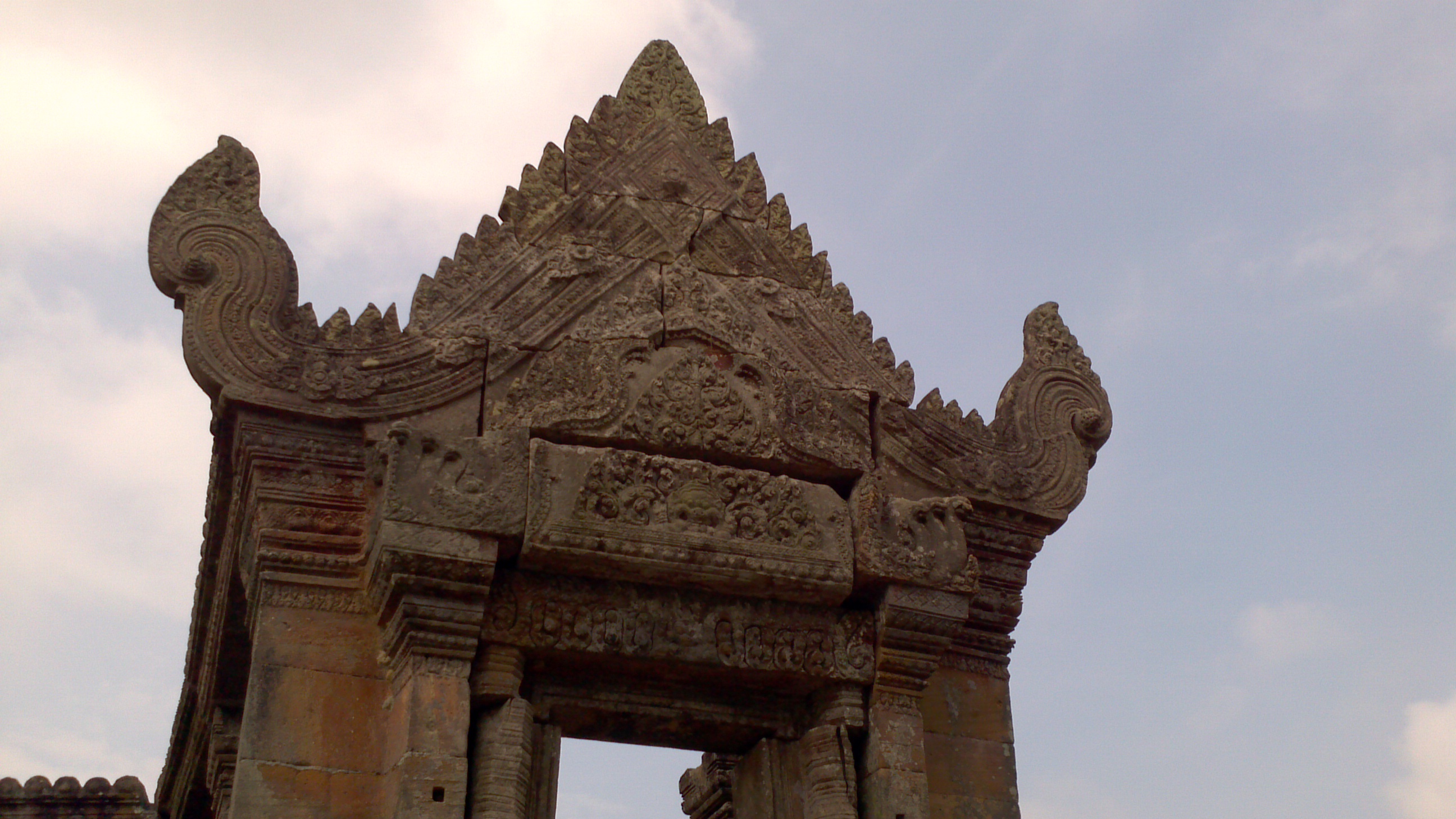
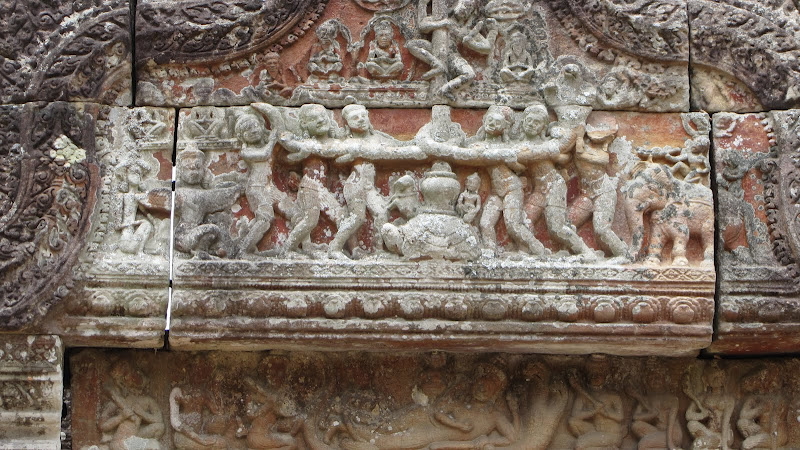
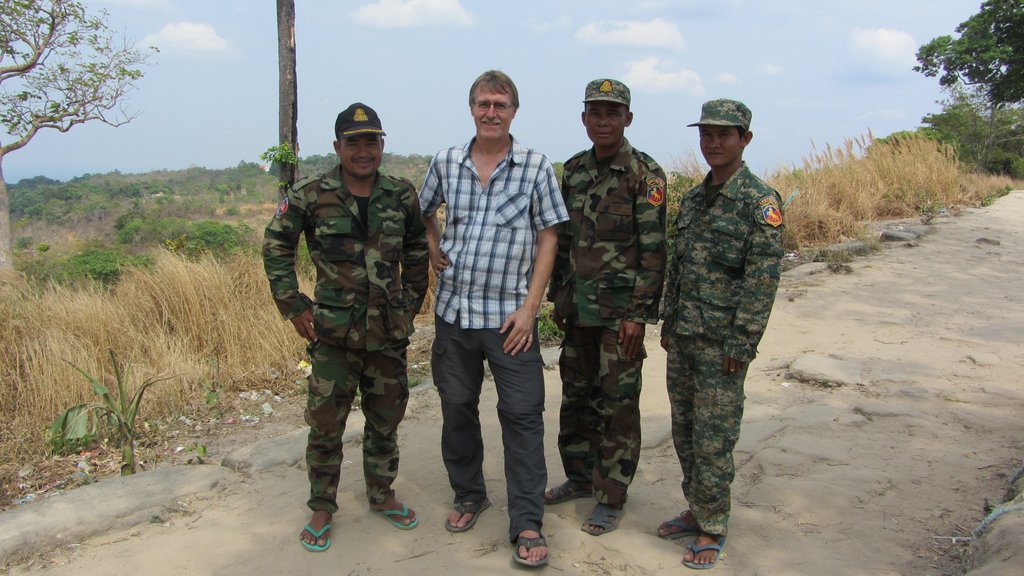

2 Responses to Picnic in a War Zone